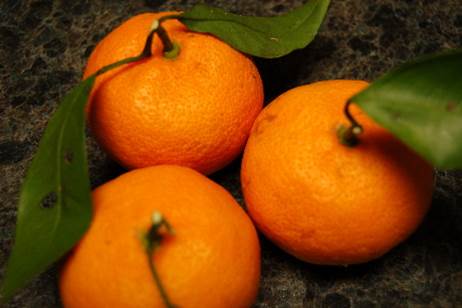
by Matthew Orwat | Nov 24, 2015

Satsuma fruit, harvested with their stem intact to ensure longevity when stored. Image Credit: Dr. Pete Andersen
The satsuma mandarin (Citrus unshiu) is a popular dooryard fruit tree, and emerging crop, across the Florida Panhandle. 100-150 years ago it was a major cash crop for the region, with boxcar loads being shipped to the Northeast during the months of October-December. Due to a series of hard freezes in the 1950s and a shift in land use from produce production to timber, the satsuma industry was effectively dead in northwest Florida until recent years, when several entrepreneurial growers have invested time and effort in bringing back this delicious citrus to the commercial scene.
Throughout this time, many homeowners have enjoyed this historic citrus, dressing many a Thanksgiving table with its beautiful bright orange fruit. Satsumas contain few seeds, are generally sweet and very easy to peel. They are part of the mandarin group of citrus, and somewhat resemble canned mandarin oranges in shape and flavor. The cooler the fall temperatures (above freezing) the sweeter the fruit will be at harvest.
Mature trees are hardy down to 14-18 º F when budded to a cold hardy rootstock such as trifoliate orange or swingle. Young trees need to be protected from temperatures below the mid 20s, and fruit will be ruined if exposed to any freezing temperatures below “light frost” conditions. Commercial growers use protective techniques, such as microirrigation, to protect their fruit if freezing temperatures threaten harvest.
This Thanksgiving, if you do not have a satsuma tree of your own, seek out a local producer and buy a case of satsumas for the holiday season !
For more information on growing and harvesting satsuma mandarins consult “The Satsuma Mandarin – HS195“, produced for your benefit by UF / IFAS Extension.
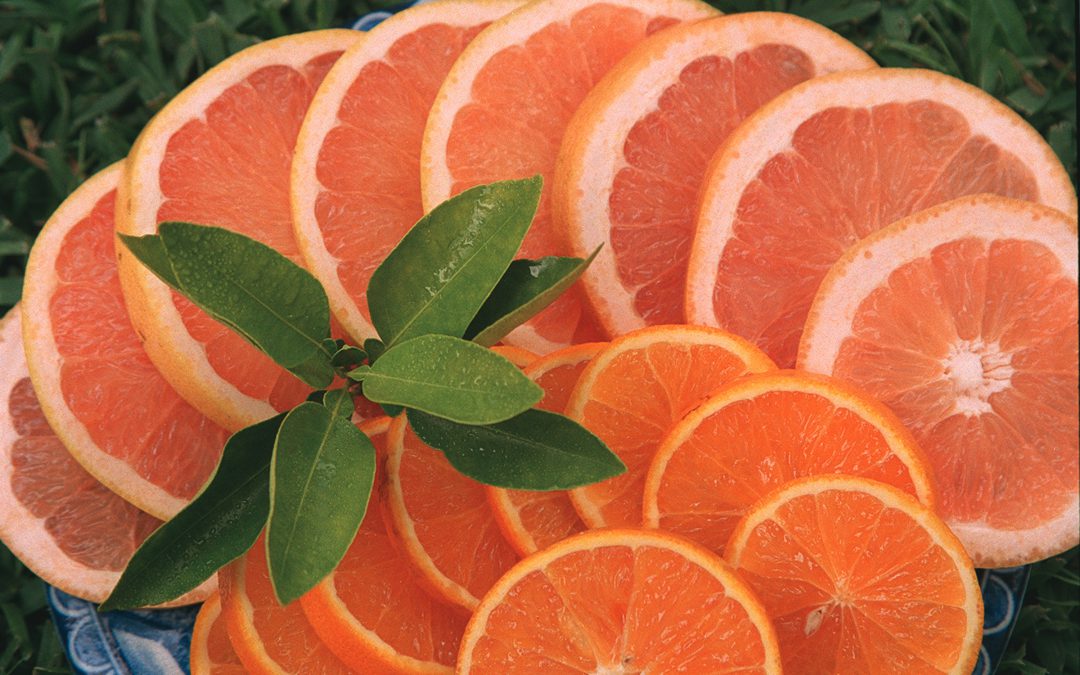
by Mary Salinas | Mar 12, 2014
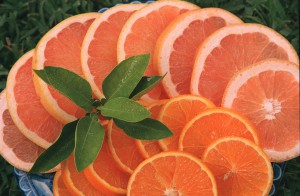
Delicious citrus! Photo by UF IFAS Thomas Wright.
All varieties of citrus – grapefruit, lemon, tangerine, kumquat and orange – are a vital part of our lives here in Florida. We love to grow citrus in our yards so that we can harvest the fruit fresh from the tree. On a wider scale, the citrus industry has a $9 billion annual impact on our economy providing over 76,000 jobs statewide.
But there are threats to our dooryard and commercial citrus from pests and disease. Only vigilance will help to combat the challenges so that we may continue to grow and enjoy our beloved citrus trees.
What can we do to protect our citrus?
- Learn about how to properly care for citrus and the pests and diseases that occur.
- Report any serious diseases like suspected citrus canker or citrus greening to the Division of Plant Industry by calling toll-free 1-888-397-1517.
- Purchase citrus trees only from registered nurseries – they may cost a little more but they have gone through an extensive process to remain disease and pest free. That will save you $$ in the long run!
- Don’t bring plants or fruit back into Florida – they may be harboring a pest!
- Citrus trees or fruit cannot move in or out of the State of Florida without a permit. This applies to homeowners as well as to the industry in order to protect our vital dooryard trees and citrus industry.
For more information please see:
Save Our Citrus Website
UF IFAS Gardening Solutions: Citrus
Citrus Culture in the Home Landscape
UF IFAS Extension Online Guide to Citrus Diseases
Your Florida Dooryard Citrus Guide – Common Pests, Disease and Disorders of Dooryard Citrus
by Larry Williams | Jan 27, 2014
This week, Northwest Florida is once again receiving some bitter cold temperatures. The freezing weather two weeks ago resulted in some cold damage to some local citrus trees. Cold injured citrus trees can take a while to become evident.
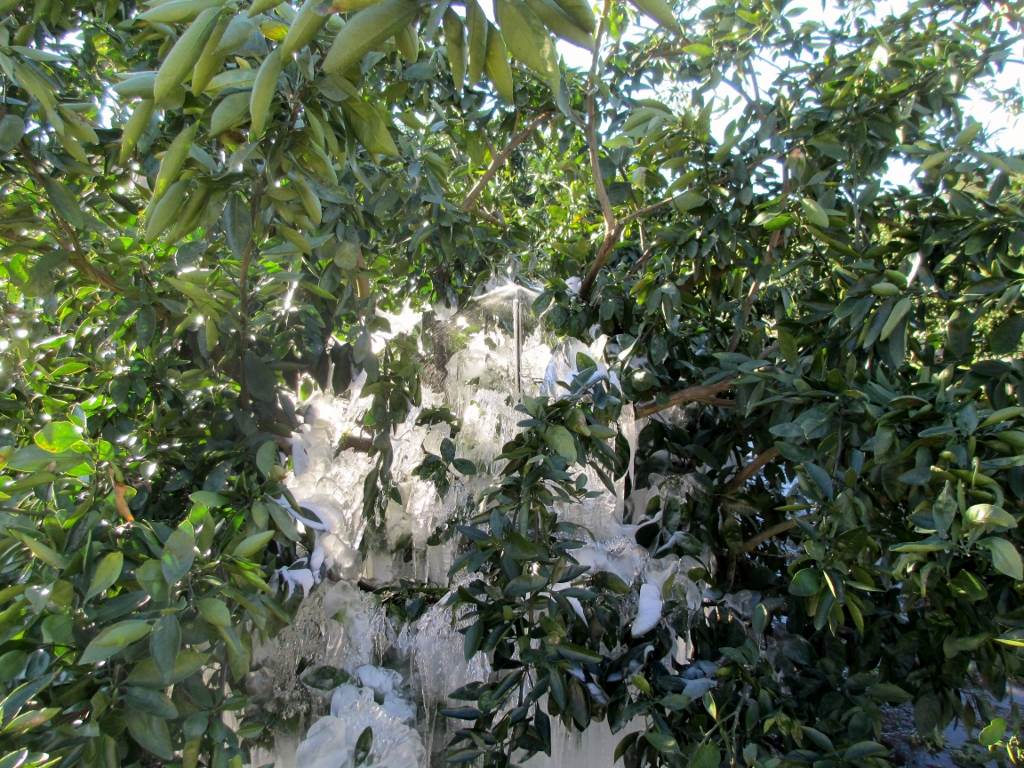
Citrus in freezing weather, under protective microsprinkler irrigation. Image Credit Doug Mayo UF IFAS
What appears to be damage will not always be permanent. Never be in a hurry to remove cold injured tissue from a citrus tree. Citrus, especially Satsuma, can be very resilient and will often re-sprout on injured tissue. Pruning before this can happen can remove fruit producing branches. Leaves on a freeze-damaged citrus tree will be hard and brittle.
If freeze damage is severe, the leaves will collapse, dry out and fall from the tree. It’s normal for leaves to take on a wilted or drooping appearance during periods of low temperatures. Don’t confuse this with freeze damage. Frozen leaves will not be wilted – they will be hard and brittle. Freeze damage can also cause the trunk and larger branches to split and the bark to become loose. Twigs and branches may continue to die for up to two years following a severe freeze.
Unless the soil becomes dry, be careful to not water cold injured citrus trees during warm periods that often follow freezes. This will delay the tree’s growth and keep the tree in a more dormant state. However, it is important to not let citrus trees go totally dry, because this will increase freeze damage. Later on, if you see that the damaged tree is putting on new growth, it’s okay to give it a little water.
It is best to not prune or fertilize citrus trees during fall and winter.Delay pruning of damaged limbs until late spring or summer because it’s difficult to determine the extent of damage until spring growth takes place. Pruning also may encourage new tender growth during the cold season.
If it appears that you’ve lost half the tree in a freeze, you’ll only need to apply about half as much fertilizer. If you have the situation where many leaves were lost but twigs and branches were not injured, you’ll need to slightly increase the amount of fertilizer. Fertilization should begin after new growth has occurred come spring. It’s a good idea to make frequent light applications rather than one heavy application.
Fertilizing your lawn during fall and winter may not only be damaging to your lawn but it can potentially cause cold injury to your citrus trees, as well. The roots on trees (including citrus) extend two to three times beyond the tree’s branches. As a result, citrus tree roots grow out into the lawn. Tree roots in the lawn are shallow. So, late applications of lawn fertilizer will impact your citrus trees as well. Your lawn and citrus needs ample time to use the fertilizer but yet still have time to go dormant before cold weather arrives.
by Matthew Orwat | Nov 18, 2013
On the night of November 13th, a mild freeze of 30°F occured in parts of Northwest Florida. Don’t be caught without a citrus protection plan !
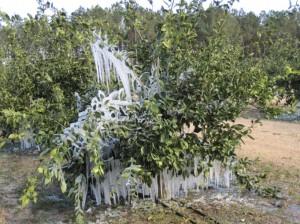
Satsuma Tree protected with micro-irrigation. Image Credit: UF IFAS Jackson County Extension
How cold does it have to get before citrus in Northwest Florida needs to be protected? A concrete answer to this question does not exist. Growers and home gardeners alike must consider several factors including type of citrus grown and the location of the citrus.
Below are a few quick facts to assist growers and home gardeners in determining whether to protect or not to protect their citrus:
- Certain citrus trees such as lime, pomelo, grapefruit, sweet orange, lemon and citron will definitely need protection or need to be moved into a sheltered area. Individuals that grow these types on a consistent basis either wrap their trees with protective covers each season or grow them in containers and move them into greenhouses.
- The meyer lemon, which is in reality a lemon-sweet orange hybrid, is a tree that was introduced to the united states in 1908. Mature dormant meyer lemons can be hardy down to 20°F, with fruit hardy to 26°F. Immature trees, or those that have not reached dormancy, should be protected. Covers made of cloth should be large enough to touch the ground so that heat from the soil can help keep the tree warm.
- Generally, satsuma are cold tolerant down to 15° F, but young trees or trees yet to achieve dormancy are usually only tolerant to 26°F. Fruit should not sustain damage from freezing temperatures above 25°F. Extreme winds sometimes make the effects of freeze events worse, so it is always better to err on the side of protection if the trees are planted in an exposed site.
- Kumquats are the most cold tolerant citrus type grown in Northwest Florida, so protection is not required unless freeze events reach 20°F.
Additional facts to assist the grower or home gardener with citrus protection:
- Plant trees on a south-facing slope, south of windbreaks, on the south side of a structure or under a light canopy if possible. South facing slopes block harmful cold winds. Structures offer radiant heat which aids in the protection of citrus trees. Additionally, light over-story pine canopies allow sufficient sunlight through while reducing frost damage.
- Wrap the trunk with commercial tree wrap or mound soil around the base of the tree up to 2 feet. This will protect the graft of the young tree. Thus, if the branches freeze the graft union will be protected.
- Cover the tree with a cloth sheet or blanket. For additional protection, large bulb Christmas lights can be placed around the branches of the tree. This will increase the temperature under the cover by several degrees. Be sure to use outdoor lights and outdoor extension cords to avoid the potential of fire.
- Water citrus trees. Well watered trees have increased cold hardiness. Do not over-water. If the ground is moist, it is not necessary to water.
- Frames may be installed around young trees to hold the cover. This option keeps the blanket or sheet from weighing down the branches.
- For large production areas, micro-irrigation is an option. This practice will protect citrus trees up to 5 feet, but must be running throughout the entire freeze event. For additional information read this publication on micro-sprinkler irrigation.
- Always remember to remove cold protection once the temperature rises so that the trees do not overheat.
- Do not cover trees with plastic tarp, these will not protect the tree and can “cook” the tree once the sun comes out.
For additional information, contact your local extension office.
by Matthew Orwat | May 9, 2013
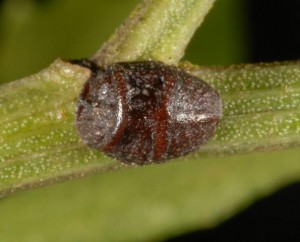
Adult Scale – Image Courtesy Lyle Buss
Many different species of scale insect infect citrus in North Florida, and mid spring is usually when gardeners notice them on their fruit trees and ornamental shrubs. Many different species of scale affect Florida homeowners and cause a host of problems in the garden and landscape. Citrus is particularly prone to scale infestations in North Florida.
The Satsuma Tangerine, Citrus unshiu, is currently a fruit that is highly prized by home gardeners in North Florida. Now is the time to act to prevent heavy scale infestations since weather is warming and control methods cannot be used when daytime temperatures are very hot. This pest has already been observed at multiple locations throughout the Florida Panhandle in both home gardens and commercial production areas.
Scale often reduces tree vitality by ingesting sap that would otherwise be used by the tree for growth and fruit production. They may also cause premature fruit drop and defoliation. A secondary pest that may occur as result of Scale is Sooty Mold. Sooty Mold lives off of the surgery secretions of the scale and can cause citrus leaves to look black and eventually drop.
The good news is that Scale is relatively easy to control when managed in winter or early in the spring growing season. From October through mid-May growers should use Horticultural Oil to control scale, particularly horticultural oil containing petroleum products. These products deprive scale insects of oxygen. This will smother them, but dead insects will need to be washed off if complete removal is desired.

Cottony Cushion Scale – Image Courtesy Matthew Orwat
Applications should be timed correctly since horticultural oil applications can burn plants once the outdoor temperature reaches 94 ® F. A good rule of thumb is to apply horticultural oil on cool and cloudy days to minimize leaf damage. Always consult the label of each individual product before application and never apply more than the recommended amount. This last statement is especially crucial for horticultural oil applications, since increased rates are highly likely to damage plants. For more information, please consult this UF / IFAS publication on Citrus Scale and the Citrus Pest Management Guide.
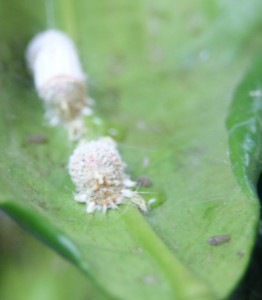
Cottony Cushion Scale – Image Courtesy Matthew Orwat









